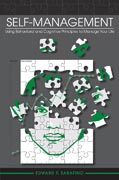
Self-management: using behavioral and cognitive principles to manage your life
Sarafino, Edward P.
INDICE: PART I The Self-Management ApproachBasic Issues Chapter 1 WHAT IS SELF-MANAGEMENT? How We Manage Our Behavior, or Dont Benefits of Self-Management Choosing and Achieving Goals Enhancing Adjustment What Do You Want for Your Life? Life Goals and Immediate Goals Beliefs about Attaining Goals Acquiring and Changing Behavior Through Learning Respondent Conditioning Operant Conditioning Modeling Cognitive Processes in Learning BehaviorWhat It Is and What It Isnt Broad Traits and Outcomes Are Not Behaviors Behavioral Deficits and Excesses How Self-Management Methods Developed Beginnings of Behavior Modification Growth of Behavior Modification Study and Review Application Exercise Chapter 2EFFECTIVE APPLICATIONS OF SELF-MANAGEMENT How We Know Self-Management Works Target Behaviors and Behavioral Goals Did a Program to Change Behavior Work? Using Data in Managing Your Behavior Why Use Data? Accuracy of the Data GraphingYour Data Making a Graph Using Graphs Examples of Effective Behavior Change Programs Behavior Modification Programs Self-Management Programs Study and Review Application Exercise Chapter 3 SPECIFYING AND ASSESSING WHAT YOU WANT TO CHANGE Specifying Your Target Behaviors Defining Operant Behaviors Defining Respondent Behaviors Alternative Behaviors and Competing Responses Assessing Your Behavior What Types of Data Can You Use? How to Assess Your Behavior Timing Your Assessments and Making Them Accurate Practical Issues in Keeping Records Setting Up a Recording System Problems in Keeping Records What about Baseline Records? What Functions Does Your Behavior Serve? Assessing the Functions of Behavior Recording Data for a Functional Assessment Going a Step Beyond: The Functional Analysis Tips on Specifying and Assessing Your Behavior Study and Review Application Exercise PART II Techniques for Changing Operant Behavior Chapter 4 IDENTIFYING, DEVELOPING, AND MANAGING OPERANT ANTECEDENTS How Antecedents Affect Our Behavior How We Learn Antecedents Learning a Discrimination Developing Stimulus Control Identifying Antecedents Antecedents for Behavioral Excesses Antecedents for Behavioral Deficits Developing or Applying New Antecedents Prompting, Fading, and Modeling Environmental Changes Cognitive Strategies Managing Existing Antecedents Avoiding and Narrowing Techniques Cognitive Approaches Altering Antecedent Chains Tips on Managing Antecedents Study and Review Application Exercise Chapter 5 CONSEQUENCES TO INCREASE OR DECREASE OPERANT BEHAVIOR How Consequences Affect Our Behavior What Is Reinforcement? What Are Extinction and Punishment? Positive and Negative Reinforcement Types of Positive Reinforcers Negative Reinforcement in Escape and Avoidance Identifying and Selecting Reinforcers Direct Assessment Methods Indirect Assessment Methods How to Administer Reinforcement Who Will Administer Reinforcement? Shaping and Chaining Timing and Scheduling Reinforcement Extinction and Punishment to Decreasea Behavior Identifying and Controlling Reinforcement for Extinction The Process of and Factors in Extinction Types of Punishment Self-Administration of Punishment Other Strategies for Decreasing a Behavior Tips on Managing Consequences Tips for Using Reinforcement Tips for Using Extinction and Punishment Studyand Review Application Exercise PART III Behavioral and Cognitive Methods to Change Emotional Behaviors and Beliefs Chapter 6 BEHAVIORAL METHODS FOR CHANGING RESPONDENT BEHAVIOR: FEELINGS AND THOUGHTS Respondent Conditioning in Real Life The Content and Process of Respondent Conditioning Conditioned Emotional Responses Other Respondent Behaviors Assessing Our Feelings and Thoughts Analyzing the Functions of Our Feelings and Thoughts Antecedents Behavior Consequences Behavioral Methods to Reduce Unwanted Feelings and Thoughts Underlying Principles: Extinction and Counterconditioning The Systematic Desensitization Technique Tips on Using Behavioral Methods to Reduce Respondent Behaviors Study and Review Application Exercise Chapter 7 AFFECTIVE AND COGNITIVE METHODS FOR CHANGING EMOTIONAL BEHAVIOR AND BELIEFS Relaxation Techniques Progressive Muscle Relaxation Meditation Rapid Relaxation Induction Covert Conditioning Covert Sensitization Covert Positive Reinforcement CognitiveBehavioral Coping Techniques Self Statements Thought Stopping and Distraction Cognitive Methods: Restructuring and Problem Solving Cognitive Restructuring Skills Problem Solving Skills Tips on Using Affective and Cognitive Techniques Study and Review Application Exercise PART IV Carrying Out Self-Management Programs Chapter 8 PUTTING TECHNIQUES TOGETHER FOR AN EFFECTIVE SELF-MANAGEMENT PLAN Combining Techniques for a Self-Management Program Identifying Possible Techniques to Use Examples of Multidimensional Programs What Will Make the Best Program for You? What Makes a Self-Management Plan Good? Deciding Which Techniques to Use Motivational Factors to Consider Peoples Readiness to Change Ways to Enhance Motivation to Change Assembling Materials for Your Program Developing a Behavioral Contract Preparing Other Program Materials Tips on Designing Your Self-Management Plan Study and Review Application Exercise Chapter 9 TAKING ACTION: IMPLEMENTING YOUR PLAN Getting Started Beginning with Baseline Recording and Graphing Your Data Using Arithmetic Calculations Is the Program Working? How to Assess a Programs Progress Problems in Graphic Analyses Troubleshooting and Improving a Program Why a Program Isnt Working How to Improve a Program Tips on Using Data andImproving Your Program Study and Review Application Exercise Chapter 10 THE FUTURE: MAINTAINING YOUR BEHAVIOR CHANGES Will the Behavior Changes Last? Relapses in Behavior Why Relapses Occur How to Maintain the Changed Behavior Thinning Reinforcement Promoting Natural Reinforcement Promoting Generalization of the Behavior CognitiveBehavioral Approaches Booster Programs and Buddy Systems How Successful Self-Management Leads to a Happier Life Tips on Maintaining Your Changed Behavior Study and Review Application Exercise
- ISBN: 978-0-470-57151-4
- Editorial: John Wiley & Sons
- Encuadernacion: Rústica
- Páginas: 272
- Fecha Publicación: 03/11/2010
- Nº Volúmenes: 1
- Idioma: Inglés
